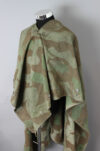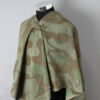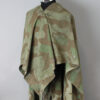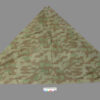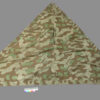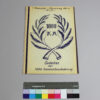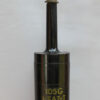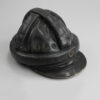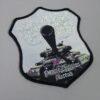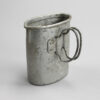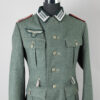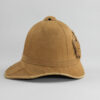Canvas with camouflage pattern
Inventory number: Ü 214
Camouflage is used to visually blend an object into its surroundings. The choice of color and pattern must be adapted depending on the area of operation and weather conditions. Almost every nation has developed and refined its own camouflage patterns. From the hand-painted color surfaces of the First World War to today’s computer-generated digital patterns, there is an almost infinite variety of camouflage patterns in military history and now even in civilian fashion.
The Italian army first used camouflage patterns for its tents and later uniforms in 1929. In 1931, the Reichswehr introduced the distinctive triangular tent panels with a camouflage pattern. Before that, the German armies used plain gray tents. The “Buntfarbendruck 31” camouflage pattern developed for the “Zeltbahn 31”, later known as the splinter pattern, shows green and brown geometric shapes on a beige background with short, dark stripes on top. It represents a further development of the contrasting patterns that were usually painted by hand on equipment such as steel helmets or military equipment during the First World War. The added line elements – like falling rain or blades of grass – were intended to blur the harsh transitions between the colors from a distance.
Not only in terms of camouflage, but also in the design of the canvas, the simple gray rectangle was abandoned. The triangular piece of fabric with various eyelets and buttons was a multifunctional tool and could be used on its own as a wind protection tent, as a stretcher for injured persons or combined with other tent panels as a sleeping tent. An opening in the middle made it possible to wear the canvas as a poncho over the uniform for rain protection.
After the invasion of the Soviet Union, splinter camouflage was used in the Wehrmacht for a large number of other items of equipment such as helmet covers, jackets, pants and gloves. Some of the equipment could be used on both sides, so that soldiers could wear the same item in splinter camouflage or in a white winter version. There were several variations of the camouflage pattern, for example the somewhat blurrier swamp camouflage. In its early years, the Bundeswehr also used a camouflage pattern that was reminiscent of the 1931 pattern, but soon replaced it with the typical Bundeswehr olive for the next few decades. However, the pattern significantly influenced the development of camouflage patterns in Eastern Europe during this time.
Object of the month
(short) stories from the depot
Unfortunately, many objects cannot currently be shown in the exhibition for conservation reasons. Here you will find unusual objects and exciting stories of special pieces from the depot

